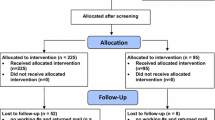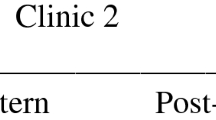Abstract
Monthly disruptive behavior treatment progress for 613 youth ages 7–18 receiving intensive in-home services was examined. Multilevel modeling indicated carrying a depressive mood diagnosis predicted less disruptive behavior progress compared to youth with only externalizing diagnoses. Paradoxically, more monthly focus on disruptive behavior treatment targets predicted lower concurrent progress ratings, while greater focus on depressive mood targets predicted greater disruptive behavior progress for youth with a depressive mood diagnosis. Findings held when other predictors of disruptive behavior progress were included as covariates, including episode length, youth age, and functional impairment. Treatment and research implications are discussed.
Similar content being viewed by others
Notes
The disruptive behavior target predictor variable included all seven targets while the outcome progress rating criterion variable was based on only three of these targets (see justification earlier). To assure this choice did not affect results, all analyses were replicated using only the subset of three disruptive behavior targets as predictors with no change in results. Data available from author.
References
American Psychiatric Association. (2000). Diagnostic and statistical manual of mental disorders (4th edn., text rev.). Washington, DC: Author.
American Psychiatric Association. (2013). Diagnostic and statistical manual of mental disorders (5th edn.). Washington, DC: Author.
Angold, A., Costello, E. J., & Erkanli, A. (1999). Comorbidity. Journal of Child Psychology and Psychiatry, 40(1), 57–87.
Baker-Ericzén, M. J., Hurlburt, M. S., Brookman-Frazee, L., Jenkins, M. M., & Hough, R. L. (2010). Comparing child, parent, and family characteristics in usual care and empirically supported treatment research samples for children with disruptive behavior disorders. Journal of Emotional and Behavioral Disorders, 18(2), 82–99.
Barlow, D. H., Farchione, T. J., Fairholme, C. P., Ellard, K. K., Boisseau, C. L., Allen, L. B., & Ehrenreich-May, J. T. (2011). Unified protocol for transdiagnostic treatment of emotional disorders: Therapist guide. New York: Oxford University Press.
Beauchaine, T. P., Hinshaw, S. P., & Pang, K. L. (2010). Comorbidity of attention-deficit/hyperactivity disorder and early-onset conduct disorder: biological, environmental, and developmental mechanisms. Clinical Psychology: Science and Practice, 17(4), 327–336.
Beauchaine, T. P., Webster-Stratton, C., & Reid, M. J. (2005). Mediators, moderators, and predictors of 1-year outcomes among children treated for early-onset conduct problems: a latent growth curve analysis. Journal of Consulting and Clinical Psychology, 73(3), 371–388.
Bickman, L. (2000). The most dangerous and difficult question in mental health services research. Mental Health Services Research, 2(2), 71–72.
Borntrager, C. F., Chorpita, B. E., Higa-McMillan, C., & Weisz, J. R. (2009). Provider attitudes toward evidence-based practices: Are the concerns with the evidence or with the manuals. Psychiatric Service, 60, 677–681.
Boylan, K., Vaillancourt, T., & Szatmari, P. (2012). Linking oppositional behavior trajectories to the development of depressive symptoms in childhood. Child Psychiatry & Human Development, 43, 484–497.
Burke, J. D., Hipwell, A. E., & Loeber, R. (2010). Dimensions of oppositional defiant disorder as predictors of depression and conduct disorder in preadolescent girls. Journal of the American Academy of Child & Adolescent Psychiatry, 49(5), 484–492.
Burke, J. D., Loeber, R., Lahey, B. B., & Rathouz, P. J. (2005). Developmental transitions among affective and behavioral disorders in adolescent boys. Journal of Child Psychology and Psychiatry, 46(11), 1200–1210.
Burke, J. D., Rowe, R., & Boylan, K. (2014). Functional outcomes of child and adolescent oppositional defiant disorder symptoms in young adult men. Journal of Child Psychology and Psychiatry, 55(3), 264–272.
Child and Adolescent Mental Health Division, Hawai’i Department of Health Child and Adolescent Mental Health Division. (2005). Service provider monthly treatment and progress summary. Honolulu, HI: Hawaii Department of Health, Child and Adolescent Mental Health Division.
Child and Adolescent Mental Health Division, Hawai’i Department of Health Child and Adolescent Mental Health Division. (2008). Instructions and codebook for provider monthly treatment and progress summary. Honolulu, HI: Hawai’i Department of Health Child and Adolescent Mental Health Division.
Child and Adolescent Mental Health Division, Hawai’i Department of Health Child and Adolescent Mental Health Division. (2012). Child and adolescent mental health performance standards. Retrieved from http://health.hawaii.gov/camhd.
Copeland, W. E., Shanahan, L., Costello, E. J., & Angold, A. (2009). Childhood and adolescent psychiatric disorders as predictors of young adult disorders. Archives of General Psychiatry, 66(7), 764–772.
Daleiden, E., Lee, J., & Tolman, R. (2004). Annual evaluation report: Fiscal year 2004. Honolulu, HI: Hawaii Department of Health.
Foster, E. M., & Jones, D. E. & The Conduct Problems Prevention Research Group. (2005). The high costs of aggression: Public expenditures resulting from conduct disorder. American Journal of Public Health, 95(10), 1767–1772.
Garland, A. F., Bickman, L., & Chorpita, B. F. (2010a). Change what? Identifying quality improvement targets by investigating usual mental health care. Administration and Policy in Mental Health and Mental Health Services Research, 37(1–2), 15–26.
Garland, A. F., Brookman-Frazee, L., Hurlburt, M. S., Accurso, E. C., Zoffness, R. J., Haine-Schlagel, R., et al. (2010b). Mental health care for children with disruptive behavior problems: A view inside therapists’ offices. Psychiatric Services, 61(8), 788–795.
Garland, A. F., Hough, R. L., McCabe, K. M., Yeh, M., Wood, P. A., & Aarons, G. A. (2001). Prevalence of psychiatric disorders in youths across five sectors of care. Journal of the American Academy of Child & Adolescent Psychiatry, 40(4), 409–418.
Heck, R. H., Thomas, S. L., & Tabata, L. N. (2013). Multilevel and longitudinal modeling with IBM SPSS: Quantitative methodology series (2nd edn.). New York: Routledge.
Hinshaw, S. P., & Lee, S. S. (2003). Conduct and oppositional defiant disorders. In E. J. Mash & R. A. Barkley (Eds.), Child Psychopathology (pp. 144–198). New York: The Guilford Press.
Hodges, K. (2000). Child and Adolescent Functional Assessment Scale. Ypsilanti, MI: Eastern Michigan University.
Hodges, K., & Gust, J. (1995). Measures of impairment for children and adolescents. The Journal of Behavioral Health Services and Research, 22(4), 403–413.
Hodges, K., & Wong, M. M. (1996). Psychometric characteristics of a multidimensional measure to assess impairment: The Child and Adolescent Functional Assessment Scale. Journal of child and Family Studies, 5(4), 445–467.
Jackson, D. S., Keir, S. S., Sender, M., & Mueller, C. W. (2017). Reliable change and outcome trajectories across levels of care in a mental health system for youth. Administration and Policy in Mental Health and Mental Health Services Research, 44(1), 141–154.
Jarrett, M., Siddiqui, S., Lochman, J., & Qu, L. (2014). Internalizing problems as a predictor of change in externalizing problems in at-risk youth. Journal of Clinical Child & Adolescent Psychology, 43(1), 27–35.
Kazdin, A. E. (1997). Conduct disorder across the life-span. In S. S. Luthar, J. A. Burack, D. Cicchetti & J. R. Weisz (Eds.), Developmental psychopathology: Perspectives on adjustment, risk, and disorder (pp. 248–272). Cambridge: Cambridge University Press.
Kazdin, A. E. (2015). Treatment as usual and routine care in research and clinical practice. Clinical Psychology Review, 42, 168–178.
Loeber, R., Burke, J. D., & Pardini, D. A. (2009). Development and etiology of disruptive and delinquent behavior. Annual Review of Clinical Psychology, 5, 291–310.
Loeber, R., & Hay, D. (1997). Key issues in the development of aggression and violence from childhood to early adulthood. Annual Review of Psychology, 48, 371–410.
Love, A. R., Mueller, C. W., Tolman, R. T., & Powell, A. K. (2014). Frequency, level, and rate of improvement for treatment targets in a children’s mental health community-based intensive in-home therapeutic setting. Administration and Policy in Mental Health and Mental Health Services Research, 41(4), 421–433.
Love, A. R., Okado, I., Orimoto, T. E., & Mueller, C. W. (2016). Factor analysis of therapist-identified treatment targets in community-based children’s mental health. Administration and Policy in Mental Health and Mental Health Services Research. https://doi.org/10.1007/s10488-016-0770-1
Matro, A. T., Milette-Winfree, M., Wilkie, D. P., Jackson, D., Maesaka, T., & Mueller, C. W. (2017, November). Limited early progress predicts unsuccessful treatment discharge in public mental health services for youth. Poster to be presented at the 51st Annual Convention of the Association for Behavioral and Cognitive Therapies. San Diego, CA
Milette-Winfree, M., & Mueller, C. (2017). Treatment-as-usual therapy targets for comorbid youth disproportionately focus on externalizing problems. Psychological Services. https://doi.org/10.1037/ser0000162
Moffitt, T. E., Caspi, A., Harrington, H., & Milne, B. J. (2002). Males on the life-course-persistent and adolescent-limited antisocial pathways: Follow-up at age 26 years. Development and Psychopathology, 14, 179–207.
Mueller, C., Tolman, R., Higa-McMillan, C. K., & Daleiden, E. (2010). Longitudinal predictors of youth functional improvement in a public mental health system. Journal of Behavioral Health Services and Research, 37, 350–362.
Nakamura, B. J., Daleiden, E. L., & Mueller, C. W. (2007). Validity of treatment target progress ratings as indicators of youth improvement. Journal of Child and Family Studies, 16(5), 729–741.
Newcorn, J. H., & Halperin, J. M. (2000). Attention-deficit disorders with oppositionality and aggression. In. In T. E. Brown (Ed.), Attention-deficit disorders and comorbidities in children, adolescents, and adults (pp. 171–207). Washington, DC: American Psychiatric Press, Inc.
Nezu, A. M., & Nezu, C. M. (1993). Identifying and selecting target problems for clinical interventions: A problem-solving model. Psychological Assessment, 5(3), 254–263. https://doi.org/10.1037/1040-3590.5.3.254.
Scott, S., Knapp, M., Henderson, J., & Maughan, B. (2001). Financial cost of social exclusion: Follow up study of antisocial children into adulthood. British Medical Journal, 323, 191–194.
Singer, J. D., & Willett, J. B. (2003). Applied longitudinal data analysis: Modeling change and event occurrence. New York: Oxford University Press.
Stalk, H., Love, A., & Mueller, C. (2015). Age of conduct disorder onset and comorbid anxiety and depression. Journal of Forensic Psychiatry and Psychology, 26, 337–350.
Stringaris, A. (2011). Irritability in children and adolescents: A challenge for DSM-5. European Child & Adolescent Psychiatry, 20, 61–66.
Weisz, J. R., Donenberg, G. R., Han, S. S., & Kauneckis, D. (1995). Child and adolescent psychotherapy outcomes in experiments versus clinics: Why the disparity? Journal of Abnormal Child Psychology, 23(1), 83–106.
Wilkie, D. P., Orimoto, T. E., Miyamoto, K. D., Stalk, H. L., & Mueller, C. W. (2016). Comorbidity of psychiatric disorders. In R. Levesque (Ed.), Encyclopedia of adolescence (2nd ed.). New York: Springer.
Acknowledgements
This study was supported in part from a research and evaluation contract awarded to the third author by the State of Hawaii Department of Health, Child and Adolescent Mental Health Division.
Author information
Authors and Affiliations
Corresponding author
Rights and permissions
About this article
Cite this article
Wilkie, D.P., Cicero, D.C. & Mueller, C.W. Disruptive Behavior Treatment Progress as a Function of Therapy Focus and Youth Diagnosis in a Community Mental Health Setting. Adm Policy Ment Health 45, 484–494 (2018). https://doi.org/10.1007/s10488-017-0840-z
Published:
Issue Date:
DOI: https://doi.org/10.1007/s10488-017-0840-z




